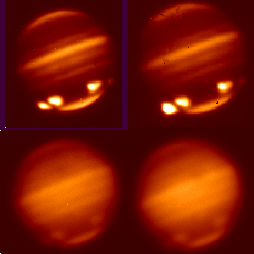
McDonald Observatory


McDonald Observatory
The cometary fragment impacts likely will release a large amount of energy into
the Jovian atmosphere. During the time of impact, University of Texas
scientists at the McDonald Observatory in Fort Davis, Texas, will investigate
the fireball of heated gas rising from the entry site; the cooling and
condensation in the upper atmosphere of the warm atmospheric and cometary material
brought up from the deep atmosphere by the fireball; the dynamics of the
atmospheric reaction to the impact event; the influence of the impact on the
Jovian magnetosphere and auroral emissions; and possible newly formed chemical
species in the stratosphere. In addition, at their McDonald Observatory
facility, Boston University scientists will conduct an intense, three-week
imaging campaign before, during and after the encounter of the state of
Jupiter's sodium magneto-nebula, the large sodium gas cloud that surrounds the
planet. Comet dust particles that are expected to align with Jupiter's magnetic
field lines will be photographed.
Public Affairs contact: Robert Tindol, University of Texas, (512) 471-3151.
Images
- McDonald Image of Fragment A & C Impacts (July 18, 1994).
- McDonald Image of Fragment A & C Impacts (July 19, 1994).
- McDonald Image of Fragment C Impact (July 19, 1994).
- McDonald Image of Fragment C (July 19, 1994).
- McDonald IMage of Fragment D & G Impacts (July 19, 1994).
- McDonald IMage of Fragment ACEFH Impacts (July 19, 1994).
- McDonald Image (July 19, 1994).
- McDonald Image Attempt at Fragment B Impact (July 17, 1994).
- McDonald Image of Fragment A, E & F Impacts (July 18, 1994).
- McDonald Image of Fragment A, E & F Impacts (July 18, 1994).
- McDonald Image of Fragment ADEF Impacts (July 18, 1994).
- McDonald Image of Fragment ADEF Impacts (July 18, 1994).
- McDonald Image of Fragment ADEFGH Impacts (July 20, 1994).
- McDonald Images of Fragment DGHL Impacts (July 20, 1994).
- McDonald Image of Fragment DGHL Impacts (July 20,
1994).
- McDonald Images of Fragment G & L Impacts (July 20, 1994).
- McDonald Images of Fragment R Impact (July 21, 1994).
- McDonald Images of Fragment DEFGHLQ12R Impacts (July 22, 1994).
- McDonald Post-Impact Images of Jupiter (August 1,
1994).
- McDonald Post-Impact Images of DGQRS Impacts (August 19-20, 1994).
 Comet Shoemaker-Levy Home Page
Comet Shoemaker-Levy Home Page





